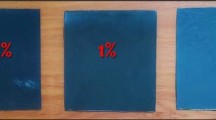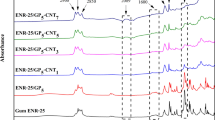Abstract
Exploiting polymer nanocomposites as dielectric and heat storage devices is an important approach to develop high performance materials. Graphite (GT), thermally reduced graphene oxide (TRG), and hybrid consisting of TRG and ionic liquid (1-Ethyl-2, 3-dimethylimidazolium bis (trifluoromethylsulfonyl) imide) modified carbon nanotubes (IMCNT) were added to natural rubber and membranes were fabricated via melt mixing method. The amount of the GT, TRG, TRG+IMCNT used in this work was in the range of 0.5 to 5 wt%. Mechanical properties of NR nanocomposites revealed that the hybrid (TRG+IMCNT) (5 wt%) system showed high tensile strength, high modulus and low elongation at break as compared to neat NR, NR reinforced with GT (5 wt%) and NR reinforced with TRG (5 wt%) systems owing to the synergistic hybrid effect caused by the network formation of the hybrid fillers inside NR matrix. Dielectric properties of the prepared membranes were studied at 2.5, 10 and 20 GHz in the microwave frequency region using a Split Post Dielectric Resonator (SPDR) based technique. The incorporation of micro and nanofillers in the natural rubber (NR) matrix results in consistent improvement in dielectric constant and lower loss tangent values. In certain cases the samples containing 5 wt% of filler exhibited high loss or conducting behaviour at higher frequencies (10 and 20 GHz). Different techniques had to be employed for measuring the dielectric constant and loss tangent of the prepared membranes where they showed a high loss or conducting behaviour. Moreover, thermal history like glass transition temperature and the change in heat capacity were estimated using Differential Scanning Calorimetry (DSC). In addition, the dispersion of micro and nanofillers inside the NR was estimated using X-ray followed by Transmission Electron Microscopy for the morphology architecture of nanofillers. The morphology of the prepared membranes was correlated with the mechanical, dielectric and thermal properties. The hybrid system (TRG+IMCNT) exhibited high dielectric constant (5.6) and low heat capacity value (0.32 J/g/°C) as compared to GT and TRG systems.












Similar content being viewed by others
References
Brosseau C, Boulic F, Queffelec P et al (1997) Dielectric and microstructure properties of polymer carbon black composites. J Appl Phys 81:882–890
Li ZH (2008) Effects of carbon blacks with various structures on vulcanization and reinforcement of filled ethylene-propylene-diene rubber. Express Polym Lett 2:695–704
Wang C, Guo Z-X, Fu S et al (2004) Polymers containing fullerene or carbon nanotube structures. Prog Polym Sci 29:1079–1141
Dennler G, Scharber MC, Brabec CJ (2009) Polymer-fullerene bulk-heterojunction solar cells. Adv Mater 21:1323–1338
Szczepanik M, Stabik J, Dybowska A (2009) Influence of graphite on electrical properties of polymer composites. Arch Mater Sci Eng 37:37–44
Compton OC, Kim S, Pierre C, Torkelson JM, Nguyen ST (2010) Crumpled graphene nanosheets as highly effective barrier property enhancers. Adv Mater 22:4759–4763
Moazzami Gudarzi M (2012) Enhancement of dispersion and bonding of graphene-polymer through wet transfer of functionalized graphene oxide. Express Polym Lett 6:1017–1031
Vega JF, Martínez-Salazar J, Trujillo M et al (2009) Rheology, processing, tensile properties, and crystallization of polyethylene/carbon nanotube nanocomposites. Macromolecules 42:4719–4727
Bokobza L (2012) Multiwall carbon nanotube-filled natural rubber: electrical and mechanical properties. Express Polym Lett 6:213–223
Ismail H, Pasbakhsh P, Fauzi MNA, Abu Bakar A (2008) Morphological, thermal and tensile properties of halloysite nanotubes filled ethylene propylene diene monomer (EPDM) nanocomposites. Polym Test 27:841–850
Tang W, Santare MH, Advani SG (2003) Melt processing and mechanical property characterization of multi-walled carbon nanotube/high density polyethylene (MWNT/HDPE) composite films. Carbon 41:2779–2785
Montazeri A, Javadpour J, Khavandi A et al (2010) Mechanical properties of multi-walled carbon nanotube/epoxy composites. Mater Des 31:4202–4208
Phang IY, Shen L, Chow SY, Zhang W-D (2004) Morphology and mechanical properties of multiwalled carbon nanotubes reinforced nylon-6 composites. Macromolecules 37:7214–7222
Müller MT, Krause B, Kretzschmar B, Pötschke P (2011) Influence of feeding conditions in twin-screw extrusion of PP/MWCNT composites on electrical and mechanical properties. Compos Sci Technol 71:1535–1542
Deng Y, Li Y, Dai J et al (2011) Functionalization of graphene oxide towards thermo-sensitive nanocomposites via moderate in situ SET-LRP. J Polym Sci A Polym Chem 49:4747–4755
Rafiee MA, Rafiee J, Srivastava I et al (2010) Fracture and fatigue in graphene nanocomposites. Small 6:179–183
Graphene A, Qi X, Pu K et al (2010) Amphiphilic graphene composites. Angew Chem Int Ed 49:9426–9429
Wu T, Pan Y, Liu E, Li L (2012) Carbon nanotube/polypropylene composite particles for microwave welding. J Appl Polym Sci 126:283–289
Theilmann P, Chu KM, Bandaru PR et al (2012) Optimisation of microwave absorption of carbon nanotube composites through use of carboxyl-epoxide functional group linkages. Electron Lett 48:638
Bhattacharya P (2013) Microwave absorption behaviour of MWCNT based nanocomposites in X-band region. Express Polym Lett 7:212–223
Al-Hartomy OA, Al-Ghamdi A, Al-Salamy F et al (2012) Dielectric and microwave properties of graphene nanoplatelets/carbon black filled natural rubber composites. Int J Mater Chem 2:116–122
Al-Hartomy OA (2012) Dielectric and microwave properties of natural rubber based nanocomposites containing graphene. Mater Sci Appl 03:453–459
Subrahmanyam KS, Vivekchand SRC, Govindaraj A, Rao CNR (2008) A study of graphenes prepared by different methods: characterization, properties and solubilization. J Mater Chem 18:1517
Krupa J, Gregory AP, Rochard OC, Clarke RN, Riddle B, Baker-Jarvis J (2001) Uncertainty of complex permittivity measurements by split-post dielectric resonator technique. J Eur Ceram Soc 21:2673–2676
Fukushima T, Kosaka A, Ishimura Y, Yamamoto T, Takigawa T, Ishii N, Aida T (2003) Molecular ordering of organic molten salts triggered by single-walled carbon nanotubes. Science 300(5628):2072–2074
Wang J, Chu H, Li Y (2008) Why single-walled carbon nanotubes can be dispersed in imidazolium-based ionic liquids. ACS Nano 2(12):2540–2546
Rao CNR, Biswas K, Subrahmanyam KS, Govindaraj A (2009) Graphene, the new nanocarbon. J Mater Chem 19:2457–2469
Chieu TC, Dresselhaus MS (1982) Raman studies of benzene-derived graphite fibers. Phys Rev B 26:5867–5877
Chen M, Park C, Choi J, Oh W (2011) Synthesis and characterization of metal (Pt, Pd and Fe)-graphene composites. J Korean Ceram Soc 48:147–151
Potts JR, Shankar O, Du L, Ruoff RS (2012) Processing–morphology–property relationships and composite theory analysis of reduced graphene oxide/natural rubber nanocomposites. Macromolecules 45:6045–6055
Lv Y, Yu L, Huang H et al (2012) Application of the soluble salt-assisted route to scalable synthesis of ZnO nanopowder with repeated photocatalytic activity. Nanotechnology 23:065402
Panigrahy B, Aslam M, Bahadur D (2012) Effect of Fe doping concentration on optical and magnetic properties of ZnO nanorods. Nanotechnology 23:115601
Kishor S, Castro M, Saiter A et al (2013) Development of poly (isobutylene-co-isoprene)/reduced graphene oxide nanocomposites for barrier, dielectric and sensing applications. Mater Lett 96:109–112
Potts JR, Shankar O, Murali S et al (2013) Latex and two-roll mill processing of thermally-exfoliated graphite oxide/natural rubber nanocomposites. Compos Sci Technol 74:166–172
Ponnamma D, Sadasivuni KK, Strankowski M et al (2013) Synergistic effect of multi walled carbon nanotubes and reduced graphene oxides in natural rubber for sensing application. Soft Matter 9:10343–10353
Jose JP, Thomas S (2014) Alumina-clay nanoscale hybrid filler assembling in cross-linked polyethylene based nanocomposites: mechanics and thermal properties. Phys Chem Chem Phys 16:14730–14740
Thomas SP, Thomas S, Bandyopadhyay S (2009) Polystyrene calcium phosphate nanocomposites : preparation, morphology, and mechanical behavior polystyrene. J Phys Chem C 113(1):97–104
Guo J, Wang X, Liao X, Zhanga W, Shi B (2012) Skin collagen fiber-biotemplated synthesis of size-tunable silver nanoparticle-embedded hierarchical intertextures with lightweight and highly efficient microwave absorption properties. J Phys Chem C 116:8188–8195
Acknowledgments
We would like to express our sincere thanks to UGC, New Delhi, DST Nanomission and Universiti Teknologi MARA, Shah Alam, Malaysia for the financial support.
Author information
Authors and Affiliations
Corresponding authors
Rights and permissions
About this article
Cite this article
Yaragalla, S., Sindam, B., Abraham, J. et al. Fabrication of graphite-graphene-ionic liquid modified carbon nanotubes filled natural rubber thin films for microwave and energy storage applications. J Polym Res 22, 137 (2015). https://doi.org/10.1007/s10965-015-0776-5
Received:
Accepted:
Published:
DOI: https://doi.org/10.1007/s10965-015-0776-5




